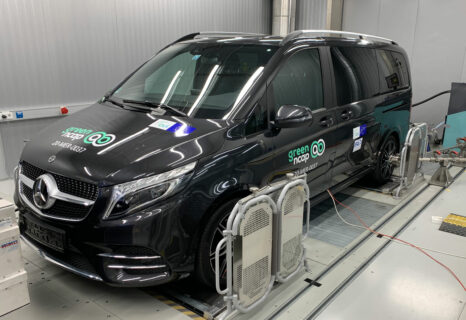Mercedes-Benz V-Class V250d diesel 4x2 automatic
2020
28%
7.2
10
Clean Air Index
1.2
10
Energy Efficiency Index
0.0
10
Greenhouse Gas Index
| Laboratory Tests | NMHC | NOX | NH3 | CO | PN | |
|---|---|---|---|---|---|---|
| 7.010 | Cold Test | |||||
| 8.210 | Warm Test | |||||
| 6.410 | Cold Ambient test | |||||
| 7.210 | Highway | |||||
| Road test | ||||||
| 7.210 | On-Road Drive | |||||
| 5.88 | On-Road Heavy Load | |||||
| 3.85 | On-Road Light Load | |||||
| 3.55 | On-Road Short Trip | |||||
| 2.02 | Congestion | |||||
| Robustness |
| Laboratory Tests | Energy | |||
|---|---|---|---|---|
| 2.210 | Cold Test | |||
| 2.910 | Warm Test | |||
| 0.010 | Cold Ambient test | |||
| 0.010 | Highway | |||
| Consumption | Driving Range | |||
| Average | 8.4l100 km | 848km | ||
| Worst-Case | 10.4l100 km | 675km | ||
| Greenhouse Gases | CO2 | N2O | CH4 | |
|---|---|---|---|---|
| 0.07 | Cold Test | |||
| 0.07 | Warm Test | |||
| 0.07 | Cold Ambient test | |||
| 0.07 | Highway |
Specifications
- Tested Car WDF4478131365XXXX
- Publication Date 11 2020
- Vehicle Class Business and Family Van
- Emissions Class Euro 6d-Temp
- Tyres 245/45 R19 Y XL
- Mass 2,359 kg
- Engine Size 1,950 cc
- Engine Power/Torque 140 kW/440 Nm
- Published CO2 202 g/km





























































































































































Our verdict
The V-Class shares its platform with the Vito, a light commercial van produced by Mercedes-Benz. Tested here as the 250d, it comes with a comprehensive array of exhaust after-treatment devices: high/low pressure exhaust gas recirculation (EGR); a diesel particulate filter (DPF); and selective catalytic reduction (SCR). Combined, these prove very effective at mitigating pollutant emissions and the vehicle scores an impressive 7.2 for Clean Air. Sadly, the vehicle is let-down by its score for Energy Efficiency where its weight counts against it. It takes a lot of energy to move a vehicle this heavy, as demonstrated by the worst-case fuel consumption of 10 l/100 km. However, used to maximum capacity, the vehicle can transport roughly double the number of people that a large SUV of similar weight would be able to. Overall, the star rating of only 1½ is a reflection of Green NCAP's holistic approach to environmental testing and would have been considerably higher were it based on Clean Air alone.